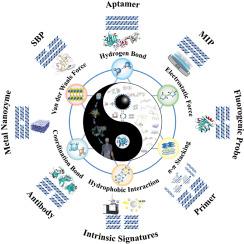Molecular recognition-driven detection of β-Lactoglobulin: Mechanisms, progress and future prospects
IF 12
1区 化学
Q1 CHEMISTRY, ANALYTICAL
引用次数: 0
Abstract
β-Lactoglobulin (BLG), the principal allergen in bovine milk, exhibits strong immunogenicity and structural stability, posing notable challenges to food safety. Accurate detection of BLG is critical for allergen labeling and consumer protection. This review systematically summarizes molecular recognition strategies for BLG detection. It defines eight recognition modes and three binding sites, and categorizes seven recognition elements, including antibodies, aptamers, specific binding peptides, molecularly imprinted polymers, fluorogenic probes, metal nanozymes, and primers, based on binding mechanisms. Additionally, direct strategies utilizing BLG's intrinsic signatures, such as mass spectrometry and spectroscopy, are reviewed. Detection platforms are evaluated in terms of sensitivity, specificity, and applicability. Future perspectives highlight advances in intelligent sensing technologies, including integration with nanomaterials, microfluidics, and digital analysis. Emphasis is placed on achieving high performance under complex food conditions. This review provides a concise reference for developing next-generation BLG biosensors with improved accuracy, portability, and suitability for real-world allergen monitoring.

分子识别驱动的β-乳球蛋白检测:机制、进展及未来展望
乳球蛋白(β-Lactoglobulin, BLG)是牛乳中的主要过敏原,具有很强的免疫原性和结构稳定性,对食品安全构成了重大挑战。准确检测BLG对过敏原标签和消费者保护至关重要。本文系统地综述了BLG检测的分子识别策略。它定义了8种识别模式和3个结合位点,并根据结合机制对抗体、适体、特异性结合肽、分子印迹聚合物、荧光探针、金属纳米酶和引物等7种识别元件进行了分类。此外,还回顾了利用BLG固有特征的直接策略,如质谱和光谱学。检测平台在敏感性、特异性和适用性方面进行评估。未来的前景突出了智能传感技术的进步,包括与纳米材料、微流体和数字分析的集成。重点是在复杂的食物条件下实现高性能。本文综述为开发下一代BLG生物传感器提供了简明的参考,该传感器具有更高的准确性、便携性和对现实世界过敏原监测的适用性。
本文章由计算机程序翻译,如有差异,请以英文原文为准。
求助全文
约1分钟内获得全文
求助全文
来源期刊

Trends in Analytical Chemistry
化学-分析化学
CiteScore
20.00
自引率
4.60%
发文量
257
审稿时长
3.4 months
期刊介绍:
TrAC publishes succinct and critical overviews of recent advancements in analytical chemistry, designed to assist analytical chemists and other users of analytical techniques. These reviews offer excellent, up-to-date, and timely coverage of various topics within analytical chemistry. Encompassing areas such as analytical instrumentation, biomedical analysis, biomolecular analysis, biosensors, chemical analysis, chemometrics, clinical chemistry, drug discovery, environmental analysis and monitoring, food analysis, forensic science, laboratory automation, materials science, metabolomics, pesticide-residue analysis, pharmaceutical analysis, proteomics, surface science, and water analysis and monitoring, these critical reviews provide comprehensive insights for practitioners in the field.
 求助内容:
求助内容: 应助结果提醒方式:
应助结果提醒方式:


